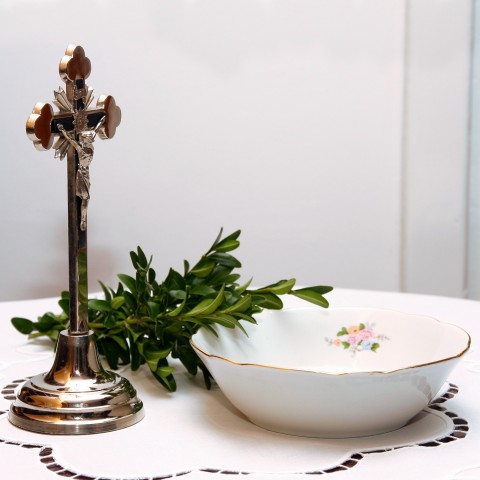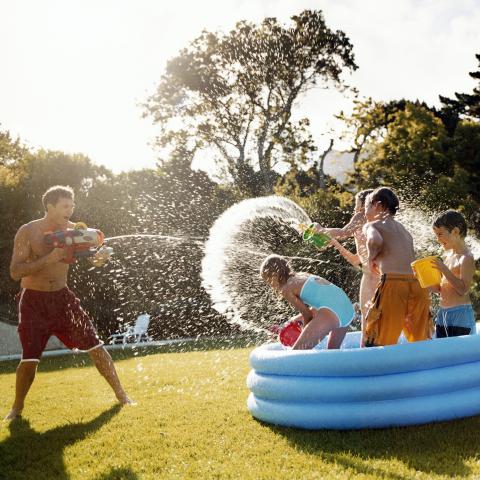The time has come to talk about Poland’s second most popular holiday: Easter. Easter Monday in Poland is not only a religious celebration, but a secular holiday enjoyed by the whole population! The Monday after Easter, called Easter Monday (or Smigus Dyngus Day in Poland), is full of Polish culture for you to discover with us.
At PolishPod101.com, we hope to make learning about Poland and the Polish language both fun and informative! And trust us: in Poland, Wet Monday is certainly fun!
1. What is Easter Monday in Poland?
On Wet Monday, Poland enjoys both a religious holiday and a day of fun!
The Easter Monday holiday in Poland is a family celebration; it is a joyful and colorful time of year, when people in Poland look forward to the upcoming spring. Further, it’s a time to celebrate the resurrection of Jesus; for those who are less religious, it’s a time to meet with their family, eat Easter breakfast together, have fun decorating eggs, and prepare special dishes.
2. When is Easter Monday?

The date of Easter Monday in Poland varies each year. For your convenience, here’s a list of this holiday’s date for the next ten years.
- 2019: April 22
- 2020: April 13
- 2021: April 5
- 2022: April 18
- 2023: April 10
- 2024: April 1
- 2025: April 21
- 2026: April 6
- 2027: March 29
- 2028: April 17
3. Reading Practice: How is Easter Celebrated in Poland?

What do Easter Monday Polish traditions look like? Read the Polish text below to find out, and learn why it’s often called Wet Monday (and find the English translation directly below it).
—
Jedną z wielu tradycji jest przygotowanie święconki, czyli koszyczka, zwykle wiklinowego, z chlebem, jajkami, kiełbasą i chrzanem czy musztardą, przyozdobionego wiosennymi kwiatami i bukszpanem. Taki oto koszyczek niesiemy, w przeddzień Wielkanocy, do kościoła, gdzie zostaje on poświęcony przez księdza. W Niedzielę Wielkanocną zanim zasiądziemy do świątecznego śniadania wszyscy domownicy dzielą się święconką, życząc sobie szczęścia i pomyślności.
Czymś, co ściśle wiąże się z Wielkanocą, są pisanki. W Polsce istnieje wiele tradycyjnych metod ozdabiania czy też farbowania jajek, które przetrwały do dziś. Pisanki to dokładnie jajka, na których rysuje się wzory za pomocą rozgrzanego wosku i następnie zanurza w barwnikach. Kraszanki natomiast, to jajka gotowane w roślinnych wywarach. Niegdyś Kościół zabraniał spożywania jajek w Wielkanoc, jako, że było ono pogańskim symbolem nowego życia.
Tym, czego nie może zabraknąc na wielkanocnym stole, poza pisankami, są wszelkiego rodzaju potrawy wykorzystujące jajka, żurek, biała kiełbasa, pasztet, najlepiej jeśli domowej roboty, oraz pascha, mazurek i babka. Sam stół jest zawsze przyozdobiony zajączkami, kurczaczkami, baziami, narcyzami, tulipanami i innymi wiosennymi kwiatami.
W Polsce kolorowe jajka nie służą tylko do ozdoby, ale również do zabawy. Prawdopodobnie najpopularniejsza gra polega na stuknięciu jednym z końców jajka o koniec jajka przeciwnika. Ten, którego jajko nie pęknie jest zwycięzcą i zabiera jajko przegranego. Walka trwa aż oba końce jajka pękną. Każde wygrane jajko należy zjeść na szczęście.
—
One of the many traditions is to prepare the swieconka, which is a basket usually made of wicker, filled with bread, eggs, sausage, and horseradish or mustard, and decorated with spring flowers and boxwood. On the day before Easter, we carry these baskets to the church, where they are blessed by the priest. On Easter Sunday, before we sit down to a festive breakfast, all household members share the blessed food and wish each other happiness and prosperity.
One thing that is closely associated with Easter is pisanki (“Easter eggs”). In Poland, many traditional methods of decorating and dyeing eggs have survived to this day. Pisanki are eggs that have patterns drawn on them with molten wax and are then immersed in dye. Kraszanki, on the other hand, are eggs that are boiled in a dye made from plants. In the past, the Church forbade the eating of eggs during Easter, as they were a pagan symbol of a new life.
One thing that can’t be missing from the Easter table, besides Easter eggs, are a few different kinds of dishes, which include eggs, sour rye soup, white sausage, pate (which is best if homemade), as well as pascha, mazurek and babka (which are both cakes). The table itself is always decorated with bunnies, chicks, catkins, narcissus, tulips, and other spring flowers.
In Poland, colored eggs are not just used for decoration, but also in games. Probably the most popular game is to tap one end of your egg against the end of an egg belonging to the opponent. The person whose egg does not break is the winner and takes the egg of the loser. The fight continues until both ends of the egg break. Each egg that has been won needs to be eaten for good luck.
4. Additional Information: Onion Skins
What is the most popular, traditional way of coloring eggs for Easter these days?
The most popular natural dye that eggs are boiled in to achieve the desired color, is one made of onion skin, which usually needs to be collected a long time before Easter. This dye gives the egg shells a beautiful golden-brown color.
5. Must-know Vocab

Here’s some vocabulary you should know for Easter Monday in Poland!
- Śmigus-dyngus — Wet Monday
- Lany Poniedziałek — Wet Monday
- Oblewać wodą — Throw water
- Psikus — Prank
- Pistolet na wodę — Water gun
- Uciekać — Run away
- Woda święcona — Holy water
- Mokry — Wet
- Zabawa — Fun
- Zwyczaj — Custom
- Czaić się — Lurk
To hear each word pronounced, check out our Polish Easter Monday vocabulary list. Here, you’ll find each word accompanied by an audio of its pronunciation.
Conclusion
What do you think about Wet Monday in Poland? Does your country have similar (or different) Easter celebrations? Let us know in the comments!
To learn more about Polish culture and the language, visit us at PolishPod101.com. We offer an array of insightful blog posts, free vocabulary lists, and an online community where you can discuss lessons with fellow Polish learners. By creating a Premium Plus account, you can also take advantage of our MyTeacher program, and learn Polish one-on-one with your own personal Polish teacher!
With enough hard work and determination, know that your Polish skills will improve tremendously. And PolishPod101.com will be here with you every step of the way!










